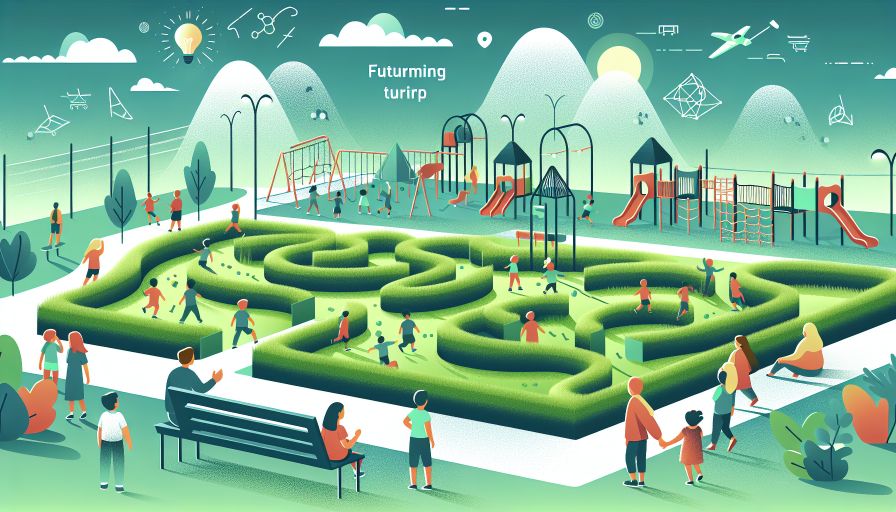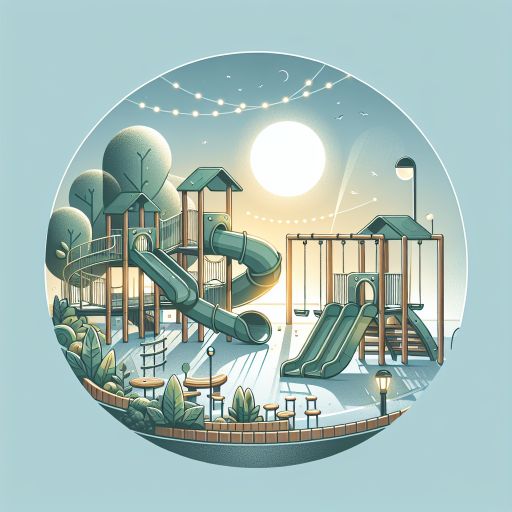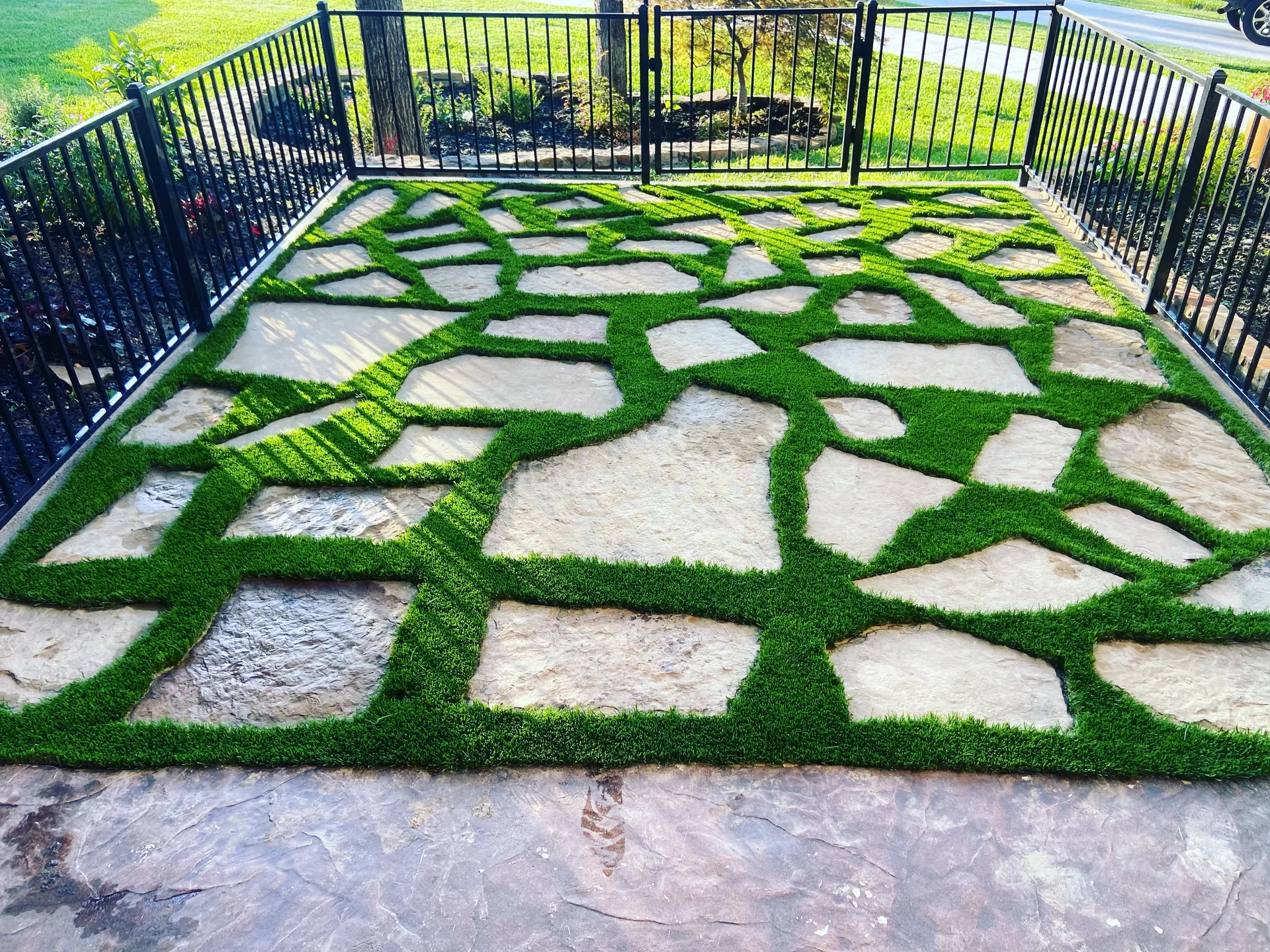
- The Evolution of Recreational Spaces: A Historical Overview
- Current Trends in Playground Design
- Innovative Turf Materials: Science and Sustainability
- Impact on Child Development and Physical Activity
- Integration of Smart Technology in Playgrounds
- Case Studies: Success Stories from Around the World
- Future Prospects and Emerging Innovations
The Evolution of Recreational Spaces: A Historical Overview
Recreational spaces have undergone significant transformations over the centuries, reflecting broader societal shifts and advancements in technology and urban planning. An understanding of the historical evolution of these spaces provides valuable context for today’s innovations in playground design and turf materials.
Early Recreational Spaces
The earliest recreational spaces can be traced back to ancient civilizations. For instance, the Greeks and Romans built public baths and gymnasiums where citizens could engage in physical activities and social interactions. These spaces were often integrated into urban areas and served as focal points for community life.
Public Parks and the Urban Movement
During the 19th century, the industrial revolution spurred a movement towards creating public parks in rapidly urbanizing areas. Prominent examples include Central Park in New York City, which was designed by Frederick Law Olmsted and Calvert Vaux in 1858. These parks were designed to provide urban dwellers with green spaces for relaxation, recreation, and a reprieve from the hustle and bustle of city life.
| Year | Significant Development |
|---|---|
| 1858 | Design of Central Park, New York |
| 1900s | Development of municipal parks in major cities |
Playground Movement
The Playground Movement, which began in the late 19th and early 20th centuries, was driven by the recognition of the importance of outdoor play for children’s development. Settlement houses, such as Chicago’s Hull House, pioneered the creation of playgrounds as part of their community services. By the mid-1920s, standardized playground designs featuring equipment like swings, slides, and seesaws became common.
Post-War Innovations
In the post-World War II era, there was a notable shift towards adventure playgrounds, first conceptualized in Denmark by Carl Theodor Sørensen. These playgrounds encouraged creative and unstructured play by providing children with materials to build and manipulate their environment. This period also saw increased attention to safety standards and the introduction of impact-absorbing surfaces.
Modern Developments
Today’s recreational spaces are influenced by a blend of historical insights and modern innovations. Factors such as environmental sustainability, inclusivity, and technological integration inform the design and materials used in playgrounds. Innovative turf designs, made from materials like recycled rubber and synthetic fibers, exemplify contemporary efforts to create safe, durable, and eco-friendly recreational surfaces.
Technological Integration
Modern playgrounds are also beginning to incorporate smart technologies, such as interactive play equipment and real-time monitoring systems. These advancements aim to enhance the play experience, improve safety, and provide valuable data for maintenance and developmental studies.
Overall, the historical trajectory of recreational spaces reveals a continuous effort to adapt and innovate in response to changing societal needs, technological advancements, and an evolving understanding of child development and community well-being.
Current Trends in Playground Design
The design of playgrounds has evolved significantly in recent years, reflecting broader trends in urban planning, sustainability, and child development. Among the most notable shifts is the increasing focus on creating safe, inclusive, and dynamic environments that cater to diverse needs.
Inclusivity has become a paramount concern. Designers are incorporating features that accommodate children of all abilities, ensuring that playgrounds are accessible to those with physical, sensory, and cognitive disabilities. This includes the use of ramps, tactile elements, and equipment designed for various age groups and abilities.
Sustainability is another key trend. Designers are prioritizing eco-friendly materials and practices. Recycled and locally sourced materials are commonly used, and there is a growing emphasis on incorporating green spaces and natural elements. This not only helps reduce the environmental impact but also promotes a connection to nature.
Safety remains a critical consideration. Advances in technology and materials have allowed for the development of surfaces and structures that minimize injury risk. Safety surfacing materials such as rubberized turf and mulch are being used to cushion falls and reduce the likelihood of serious injuries.
Moreover, there is a trend towards creating multi-functional spaces that serve various community needs. Playgrounds are being designed to double as social hubs, incorporating features such as seating areas, gardens, and event spaces. This approach encourages intergenerational interaction and community engagement.
Aesthetic appeal and thematic design are also gaining importance. Playgrounds are no longer seen as mere functional spaces but as integral parts of the urban landscape. Designers and architects are utilizing vibrant colors, unique shapes, and innovative layouts to create visually appealing environments that stimulate imagination and creativity.
Overall, the current trends in playground design reflect a comprehensive approach that balances safety, inclusivity, sustainability, and community engagement. These advancements are setting the stage for the next generation of recreational spaces that will foster healthier and happier communities.
Innovative Turf Materials: Science and Sustainability
Playgrounds have come a long way since their inception, transitioning from simple sand and natural grass to advanced turf materials that are both scientifically advanced and environmentally sustainable. The focus on innovative turf materials aims to enhance the play experience while offering durability, safety, and eco-friendliness. This chapter delves into the science and sustainability of these cutting-edge turf materials.
Science Behind Innovative Turf Materials
Modern turf materials are designed using a combination of synthetic and natural components to optimize safety, longevity, and environmental impact. Key materials include:
- Recycled Rubber: Often sourced from old tires, recycled rubber provides a shock-absorbing layer that reduces the risk of injury during falls. It also offers high durability and is weather-resistant.
- Polyethylene and Polypropylene Fibers: These synthetic fibers are engineered to mimic the look and feel of natural grass while offering superior resilience and reduced maintenance requirements.
- Organic Infill: Composed of natural materials like cork and coconut husks, organic infill is used to support the synthetic grass fibers. It enhances shock absorption, reduces temperature fluctuations, and is biodegradable.
Advanced manufacturing techniques have allowed for the creation of turf materials that feature high drainage capabilities, reducing water accumulation and making surfaces safer and more playable quickly after rain events. UV protection is also embedded into the fibers to prevent degradation from sunlight exposure.
Sustainability and Environmental Impact
Environmental sustainability is a significant concern in modern playground design. Traditional play surfaces like natural grass can require substantial amounts of water, pesticides, and regular maintenance. In contrast, innovative turf materials focus on reducing environmental footprints. Here’s how:
- Low Water Usage: Synthetic turf does not require irrigation, saving thousands of gallons of water annually compared to natural grass.
- Recyclability: Many modern turf materials are recyclable, reducing landfill waste and promoting a circular economy.
- Reduced Chemical Use: Unlike natural grass that needs fertilizers and pesticides, synthetic turfs do not require chemical treatments, thus minimizing the release of harmful substances into the environment.
- Energy Efficiency: The production of turf materials often uses less energy over time compared to the constant care required by natural grass.
Furthermore, some innovative turfs employ eco-friendly methods in their production processes. For instance, the use of natural colorants and renewable resources in manufacturing underscores a continuous drive towards sustainability in playground turf design.
Incorporating sustainable practices not only benefits the environment but also resonates with modern societal values, emphasizing the importance of responsible resource use and long-term environmental stewardship.
Impact on Child Development and Physical Activity
Innovative turf design is increasingly recognized for its significant positive impact on child development and physical activity. By offering safer, more engaging surfaces, modern turf solutions encourage various developmental benefits for children.
Cognitive Development
Research suggests that engaging playground environments can enhance cognitive development. According to a study published in the Journal of Environmental Psychology, naturalistic playgrounds with diverse textures and structural elements stimulate curiosity and problem-solving skills in children. Enhanced turf designs provide varied tactile experiences that mimic grass and other natural surfaces, which can contribute to cognitive engagement and exploration.
Physical Activity
The availability of well-designed recreational spaces directly influences levels of physical activity among children. Data from the Centers for Disease Control and Prevention (CDC) indicates that children are more likely to engage in active play when playgrounds are inviting and inclusive. Innovative turf, with its enhanced safety features and aesthetic appeal, encourages children to spend more time playing, thereby promoting physical fitness and combating childhood obesity.
Social Development
Improved playground surfaces can also foster social interactions and cooperation among children. The American Journal of Public Health highlights that safe and accessible play areas help children develop social skills such as sharing, teamwork, and communication. Modern turf designs often incorporate inclusive elements that accommodate children with disabilities, ensuring that play spaces are equitable and supportive of social inclusion.
Safety and Risk Management
Safety remains a critical aspect of child development on playgrounds. According to the National Program for Playground Safety, injuries on playgrounds can often deter parents and children from utilizing these spaces. Innovative turf materials, designed to reduce impact and provide better traction, significantly lower the risk of injuries from falls, thereby creating a safer environment that encourages more frequent use.
Environmental Interaction
Exposure to outdoor environments is beneficial for children’s development. The Environmental Health Perspectives journal notes that natural and semi-natural playgrounds contribute positively to mental health, reducing stress and fostering emotional resilience in children. By replicating natural conditions, innovative turf designs help children reconnect with nature, promoting environmental awareness and stewardship from a young age.
Overall, the advancements in turf design are essential in creating recreational spaces that support multifaceted aspects of child development, making them not just places of play, but integral components of childhood growth and well-being.
Integration of Smart Technology in Playgrounds
The integration of smart technology in playgrounds is revolutionizing the way children and communities engage with recreational spaces. This chapter delves into various smart technologies that are currently being implemented and their potential impacts on playground environments.
Smart technology in playgrounds often involves the use of sensors, interactive equipment, and connectivity solutions that can enhance safety, functionality, and engagement. For example, many modern playgrounds now feature smart lighting systems that adjust based on natural light conditions, improving visibility and extending the usability of the space into evening hours.
Another popular innovation is the inclusion of interactive play systems. These systems use embedded sensors and software to create dynamic and adaptable play environments. This can include equipment that responds to movement, touch, or sound, which encourages active play and engagement. These interactive elements can cater to different age groups and abilities, making playgrounds more inclusive.
Additionally, connectivity solutions play a crucial role in the smart playground ecosystem. Wireless networks and IoT (Internet of Things) devices enable playgrounds to collect data on usage patterns, equipment performance, and safety issues. This data can be used by municipalities and designers to make informed decisions about maintenance, upgrades, and overall design improvements.
Below is a table highlighting various smart technologies and their applications in playgrounds:
| Technology | Application |
|---|---|
| Smart Lighting | Automatically adjusts based on natural light, improves visibility, and energy efficiency. |
| Interactive Play Systems | Uses sensors to create responsive play environments that encourage physical activity and engagement. |
| Connectivity Solutions | Enables data collection on usage patterns and equipment performance to inform maintenance and upgrades. |
| Safety Sensors | Monitors equipment and ambient conditions to alert for potential hazards. |
The positive impact of these technologies extends beyond just play. For instance, safety sensors can significantly reduce the risk of injuries by monitoring equipment conditions and alerting supervisors to potential hazards. Similarly, data analytics derived from connectivity solutions can lead to more sustainable and efficient maintenance schedules, ensuring that playgrounds remain safe and enjoyable for longer periods.
While smart technologies offer numerous benefits, it is essential to consider potential challenges as well. Issues such as privacy concerns, data security, and the initial costs of implementation need to be addressed to ensure the successful adoption of these innovations in playground settings.
In conclusion, the integration of smart technology in playgrounds presents a promising avenue for enhancing recreational spaces. By leveraging advanced technologies, playgrounds can become safer, more engaging, and inclusive environments for children and communities alike.
Case Studies: Success Stories from Around the World
At Prime Design Turf, the transformation of recreational spaces has taken a significant leap, particularly through innovative turf design. With over 20 years of experience, Prime Design Turf has become a leader in the industry, demonstrating the practical benefits and aesthetic improvements that synthetic turf can bring to playgrounds and recreational areas.
One remarkable aspect of Prime Design Turf’s approach is their dedication to personal service and creative design. This combination ensures that every project meets specific community needs and enhances user experience. Their work ranges from creating visually appealing landscapes to installing safe, durable, and eco-friendly turf solutions for playgrounds and parks.
For instance, Prime Design Turf has successfully revamped numerous playgrounds by incorporating toxic-free and pet-friendly synthetic turf. This move not only assures the safety of children and pets but also contributes to the overall sustainability of the play areas. The turf is designed to withstand heavy foot traffic, reducing wear and tear while maintaining a lush, green appearance all year round.
Moreover, their commitment to sustainable materials and meticulous installation techniques ensures that playgrounds are both environmentally friendly and cost-effective. This approach highlights Prime Design Turf’s commitment to reducing maintenance costs for municipalities and private entities, thus enabling more sustainable management of recreational spaces.
To illustrate, Prime Design Turf’s projects span various settings, from local community parks to larger regional playgrounds. Each project illustrates their ability to adapt designs to meet unique challenges, whether through innovative drainage systems, specialized underlays that enhance safety, or vibrant, customizable color schemes that make play areas more inviting.
In summary, Prime Design Turf’s extensive portfolio showcases how modern turf design can transform playgrounds into safer, more appealing, and environmentally sustainable recreational spaces. Their blend of expertise, creative ingenuity, and personal service sets a benchmark in the industry, offering a model for others to follow in the future of recreational space design.
Future Prospects and Emerging Innovations
The future of recreational spaces is poised to witness transformative changes driven by advancements in turf design and materials. One significant area of innovation involves the development of play surfaces that not only enhance safety and durability but also provide a stimulating environment for children.
Emerging innovations in turf design are leading to the creation of multi-functional recreational spaces. These turfs combine diverse materials, integrating aspects like cushioning, interactive elements, and eco-friendly components. For instance, next-generation artificial grass is being engineered with improved durability and water permeability, which helps in maintaining a more consistent and safe surface for play regardless of weather conditions.
The focus on sustainability is also shaping the future of playground turfs. Biodegradable materials and recyclable components are increasingly being used in turf manufacturing, reducing the environmental impact of these recreational spaces. Innovations such as thermoplastic elastomers (TPE) and thermoplastic vulcanizates (TPV) are providing alternatives to traditional rubber, offering enhanced resilience and recyclability.
Moreover, there is a growing interest in incorporating sensory experiences directly into the turf design. This involves integrating colors, textures, and interactive features that engage multiple senses and enhance the play experience. For instance, some turfs now come embedded with LEDs that light up upon impact, providing visual stimulation and encouraging children to explore and interact with the space in novel ways.
Safety continues to be a paramount concern driving innovations in turf design. New developments include antimicrobial treatments that minimize the risk of infections and advanced shock-absorption technologies that reduce the likelihood of injuries from falls. These innovations aim to create playgrounds where children can play freely and safely.
Lastly, the future of playground turf design is expected to see an increased integration of data-driven features. Sensors embedded within turfs can collect data on usage patterns, weather conditions, and maintenance needs, which can then be analyzed to optimize the management and upkeep of these spaces. This smart technology promises to make recreational areas more efficient and responsive to the needs of their users.
The continuous evolution of turf design, driven by technological and material advancements, emphasizes a future where playgrounds are not just spaces for play, but dynamic environments that cater comprehensively to the well-being and development of children.



